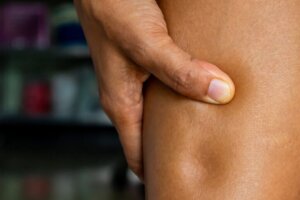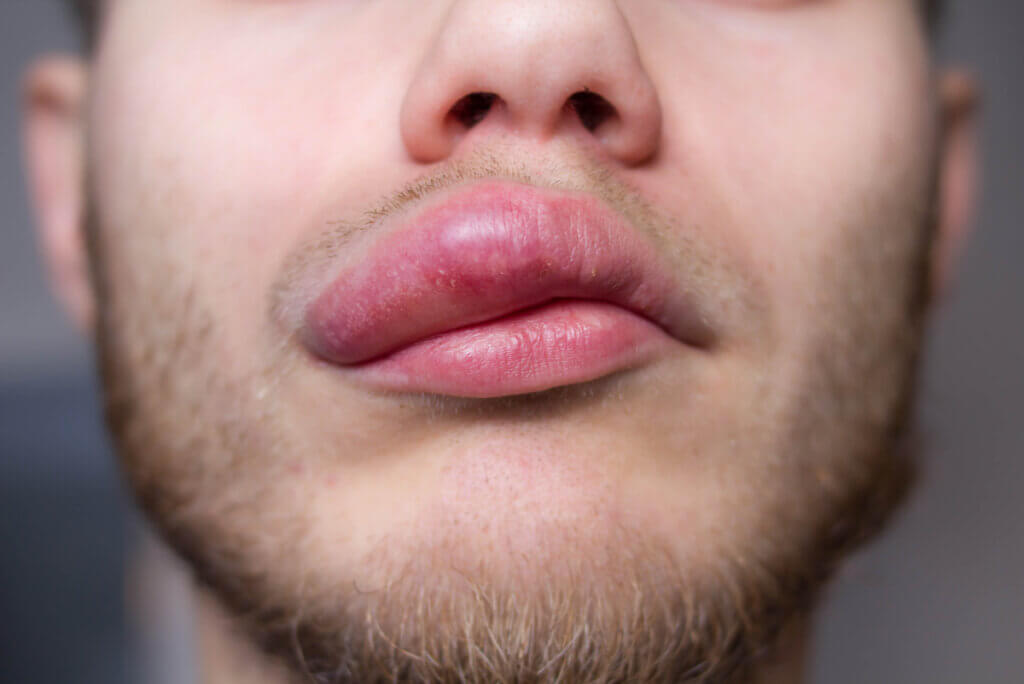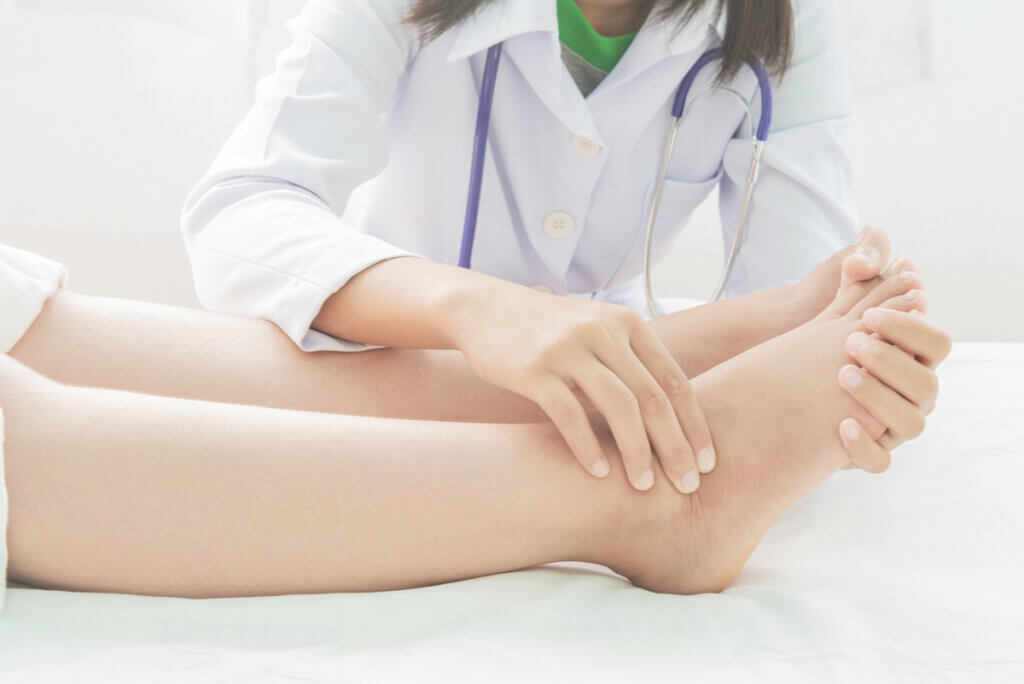6 Symptoms that Indicate Fluid Retention

Generally speaking, 60% of the human body is made up of water. This vital liquid must be in perfect balance so that the body can perform its functions properly. Some diseases are capable of altering this balance and causing the retention of fluids. Therefore, in the following article, we’ll discuss 6 symptoms that indicate fluid retention.
First of all, it’s important to know that water is distributed in different spaces within the body. Of the total 60%, 40% is found inside the cells, while the remaining 20% is found in a space called the interstitium and in the blood vessels.
All the water in our body is in constant motion. In this way, it’s able to pass from the cell to the interstitium and then to the blood vessels. Therefore, tissues can eliminate waste and absorb nutrients for proper functioning.
What’s fluid retention or edema?
This is nothing more than the excessive accumulation of liquids in the space that surrounds the cells or interstitium, caused by an alteration in the Starling forces. These forces are what regulate the balance of water in body spaces.
Starling forces state that the amount of water that leaves the interstitium at the arterial end of the capillaries must be equal to that that returns at the venous end. According to the pathophysiology of edema, it occurs when the output exceeds the return.
Various kidney and heart conditions and even those caused by alcoholism are capable of causing fluid retention. Both your symptoms and your treatment may vary. However, in all these diseases, water will accumulate under the skin and in various tissues, affecting its functioning.

6 symptoms that indicate fluid retention
As we mentioned, the symptoms that indicate the excessive presence of fluids in the body can vary depending on the cause of the problem. However, most patients usually present the following symptoms.
1. Swelling of the extremities, face, or abdomen
Inflammation will always be one of the most characteristic symptoms of fluid retention. However, its presentation may vary. When the cause is kidney disease, the inflammation will start in the morning on the face, especially around the eyelids.
On the other hand, if the fluid retention is caused by a heart condition, the swelling will focus on the legs and feet, especially in the afternoon or at night. Finally, if the cause is liver failure, there will be abdominal edema known as ascites.
It’s important to note that in all cases the edema will be symmetrical, that is, it will be the same on both sides of the body. This is important to consider, as it must be distinguished from a lymphatic condition or an infection, in which there will be asymmetric distribution.
2. Feeling that clothing or accessories are too tight
In many cases, the inflammation in the body can be so subtle that it’s not noticeable to the naked eye. Therefore, one of the symptoms that could indicate fluid retention is the sudden sensation of clothing or accessories that are very tight without any explanation.
Water will accumulate under the skin, making various parts of the body, such as fingers, ankles, or waist, larger. As you go up in size, items (rings, shoes, and pants) may feel tighter than usual.
3. Thin, shiny, and itchy skin
As water accumulates under the skin, it will stretch due to excess fluid. Forced stretching of it will give it a thin and shiny appearance, in addition to making it difficult to fold, giving rise to an injury known as sclerosis.
On the other hand, any disease that can cause fluid retention can cause kidney failure in the long term. Once this point is reached, the skin becomes pruritic, very itchy or stinging. This is due to the accumulation of urea crystals in the skin tissues.
4. General heaviness and weight gain
Generalized heaviness is among the most common symptoms of fluid retention. An inexplicable increase in the amount of water will increase body weight, so it’s possible to report a feeling of heaviness and even fullness.
On the other hand, due to the sudden increase in weight and the possible accumulation of water in the joints, it can be difficult to execute certain movements, such as the flexion of the fingers. The body will be handling water levels to which it is accustomed, so certain activities will be difficult.
5. Reduced urine output
Whenever there’s fluid retention, the kidneys will have problems producing urine. This is because the body sends a signal indicating that there’s little water in the blood vessels and that the elimination of liquids should be reduced.
This will result in patients urinating fewer times during the day. A person can go from urinating 5 to 6 times to doing it only 2 or 3, as a result of fluid retention.
6. Sunken skin when exerting pressure
A quick way to verify that there’s edema is through the pitting medical sign. This consists of pressing one or two fingers on the skin for a few seconds. When removing the pressure, if the skin continues sunken, it will indicate the presence of water under it.

How to prevent fluid retention?
Many of the ways to prevent fluid retention are related to diet. In this regard, salt intake should first be reduced, as this will greatly decrease the renal reabsorption of water. Another great dietary tip is to watch your protein intake. Both the deficit and the excess of these macronutrients can generate edema.
As contradictory as it sounds, increasing water consumption helps control fluid retention, as dehydration is usually one of its main causes. Various studies have shown that drinking 2 liters of water a day is the optimal measure in general terms.
If there’s already a predisposing factor, such as kidney disease, a possible treatment will be diuretic drugs. However, this should always be done under strict medical supervision and is a professional therapeutic approach.
Finally, exercising is the solution to many health problems and fluid retention is no exception. Different sports and physical activities improve circulation and contribute to maintaining the hydroelectrolytic balance.
What to do if I retain liquids?
The most important thing if you notice the presence of some of the symptoms that indicate fluid retention is to see a doctor. Remember that this is usually a complication of severe heart and kidney diseases, so you must be very careful.
On the other hand, edema isn’t always a cause for alert. Various situations, such as pregnancy or spending a lot of time sitting, can favor its appearance. However, it’s best to go to the specialist and thus rule out any underlying disease.
Generally speaking, 60% of the human body is made up of water. This vital liquid must be in perfect balance so that the body can perform its functions properly. Some diseases are capable of altering this balance and causing the retention of fluids. Therefore, in the following article, we’ll discuss 6 symptoms that indicate fluid retention.
First of all, it’s important to know that water is distributed in different spaces within the body. Of the total 60%, 40% is found inside the cells, while the remaining 20% is found in a space called the interstitium and in the blood vessels.
All the water in our body is in constant motion. In this way, it’s able to pass from the cell to the interstitium and then to the blood vessels. Therefore, tissues can eliminate waste and absorb nutrients for proper functioning.
What’s fluid retention or edema?
This is nothing more than the excessive accumulation of liquids in the space that surrounds the cells or interstitium, caused by an alteration in the Starling forces. These forces are what regulate the balance of water in body spaces.
Starling forces state that the amount of water that leaves the interstitium at the arterial end of the capillaries must be equal to that that returns at the venous end. According to the pathophysiology of edema, it occurs when the output exceeds the return.
Various kidney and heart conditions and even those caused by alcoholism are capable of causing fluid retention. Both your symptoms and your treatment may vary. However, in all these diseases, water will accumulate under the skin and in various tissues, affecting its functioning.

6 symptoms that indicate fluid retention
As we mentioned, the symptoms that indicate the excessive presence of fluids in the body can vary depending on the cause of the problem. However, most patients usually present the following symptoms.
1. Swelling of the extremities, face, or abdomen
Inflammation will always be one of the most characteristic symptoms of fluid retention. However, its presentation may vary. When the cause is kidney disease, the inflammation will start in the morning on the face, especially around the eyelids.
On the other hand, if the fluid retention is caused by a heart condition, the swelling will focus on the legs and feet, especially in the afternoon or at night. Finally, if the cause is liver failure, there will be abdominal edema known as ascites.
It’s important to note that in all cases the edema will be symmetrical, that is, it will be the same on both sides of the body. This is important to consider, as it must be distinguished from a lymphatic condition or an infection, in which there will be asymmetric distribution.
2. Feeling that clothing or accessories are too tight
In many cases, the inflammation in the body can be so subtle that it’s not noticeable to the naked eye. Therefore, one of the symptoms that could indicate fluid retention is the sudden sensation of clothing or accessories that are very tight without any explanation.
Water will accumulate under the skin, making various parts of the body, such as fingers, ankles, or waist, larger. As you go up in size, items (rings, shoes, and pants) may feel tighter than usual.
3. Thin, shiny, and itchy skin
As water accumulates under the skin, it will stretch due to excess fluid. Forced stretching of it will give it a thin and shiny appearance, in addition to making it difficult to fold, giving rise to an injury known as sclerosis.
On the other hand, any disease that can cause fluid retention can cause kidney failure in the long term. Once this point is reached, the skin becomes pruritic, very itchy or stinging. This is due to the accumulation of urea crystals in the skin tissues.
4. General heaviness and weight gain
Generalized heaviness is among the most common symptoms of fluid retention. An inexplicable increase in the amount of water will increase body weight, so it’s possible to report a feeling of heaviness and even fullness.
On the other hand, due to the sudden increase in weight and the possible accumulation of water in the joints, it can be difficult to execute certain movements, such as the flexion of the fingers. The body will be handling water levels to which it is accustomed, so certain activities will be difficult.
5. Reduced urine output
Whenever there’s fluid retention, the kidneys will have problems producing urine. This is because the body sends a signal indicating that there’s little water in the blood vessels and that the elimination of liquids should be reduced.
This will result in patients urinating fewer times during the day. A person can go from urinating 5 to 6 times to doing it only 2 or 3, as a result of fluid retention.
6. Sunken skin when exerting pressure
A quick way to verify that there’s edema is through the pitting medical sign. This consists of pressing one or two fingers on the skin for a few seconds. When removing the pressure, if the skin continues sunken, it will indicate the presence of water under it.

How to prevent fluid retention?
Many of the ways to prevent fluid retention are related to diet. In this regard, salt intake should first be reduced, as this will greatly decrease the renal reabsorption of water. Another great dietary tip is to watch your protein intake. Both the deficit and the excess of these macronutrients can generate edema.
As contradictory as it sounds, increasing water consumption helps control fluid retention, as dehydration is usually one of its main causes. Various studies have shown that drinking 2 liters of water a day is the optimal measure in general terms.
If there’s already a predisposing factor, such as kidney disease, a possible treatment will be diuretic drugs. However, this should always be done under strict medical supervision and is a professional therapeutic approach.
Finally, exercising is the solution to many health problems and fluid retention is no exception. Different sports and physical activities improve circulation and contribute to maintaining the hydroelectrolytic balance.
What to do if I retain liquids?
The most important thing if you notice the presence of some of the symptoms that indicate fluid retention is to see a doctor. Remember that this is usually a complication of severe heart and kidney diseases, so you must be very careful.
On the other hand, edema isn’t always a cause for alert. Various situations, such as pregnancy or spending a lot of time sitting, can favor its appearance. However, it’s best to go to the specialist and thus rule out any underlying disease.
- Flores-Villegas B, Flores-Lazcano I, Lazcano-Mendoza ML. Edema. Enfoque clínico. Medicina Interna de México. 2014;30:51-55.
- Roriz M, Henniart A. Edemas. EMC – Tratado de Medicina. 2020;24(3):1-5.
- Fauci A, Hauser S, Jameson J, Longo D, Loscalzo J, Kasper D. Harrison: Manual de Medicina Interna. 19th ed. México D.F: McGRAW-HILL INTERAMERICANA EDITORES, S.A.; 2017.
- Junta Editorial de Cancer.net. Retención de líquidos o edema [Internet]. Cancer.Net. 2017 [cited 3 November 2020]. Available from: https://www.cancer.net/es/asimilaci%C3%B3n-con-c%C3%A1ncer/efectos-f%C3%ADsicos-emocionales-y-sociales-del-c%C3%A1ncer/manejo-de-los-efectos-secundarios-f%C3%ADsicos/retenci%C3%B3n-de-l%C3%ADquidos-o-edema.
- Personal de Mayo Clinic. Edema – Diagnóstico y tratamiento [Internet]. Mayo Clinic. 2018 [cited 3 November 2020]. Available from: https://www.mayoclinic.org/es-es/diseases-conditions/edema/diagnosis-treatment/drc-20366532.
- Thompson A, Shea M. Edema – Trastornos cardiovasculares [Internet]. Manual MSD versión para profesionales. 2018. Available from: https://www.msdmanuals.com/es-ve/professional/trastornos-cardiovasculares/s%C3%ADntomas-de-las-enfermedades-cardiovasculares/edema.
Este texto se ofrece únicamente con propósitos informativos y no reemplaza la consulta con un profesional. Ante dudas, consulta a tu especialista.







